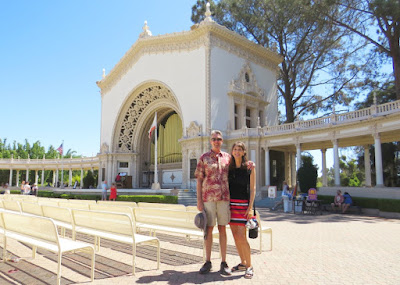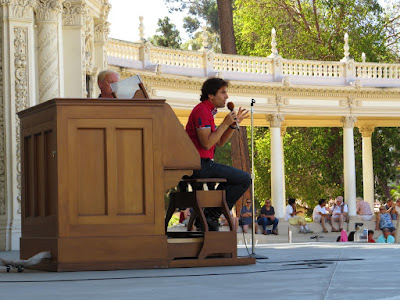Our 34th Anniversary in San Diego...
Balboa Park is a 106 year old treasure! Each time we visit, we always see/do/experience/enjoy something new and unforgettable. Today was no different... Wow!
To see a concert of the Spreckels Organ, at its exceptional Pavilion, was high on our "must do" list.This first-of-its-kind organ, designed to play for an outdoor audience, has been amazing music-lovers since December 31, 1914, when from his presidential desk, Woodrow Wilson touched the telegraph key that set off fireworks and lit the Pavilion’s 1,644 incandescent bulbs to launch the Panama-California International Exposition.
The Austin pipe organ, and the Pavilion designed by Harrison Albright to house it, were a gift from brothers John and Adolph Spreckels to the people of the world, offering free music in the days before commercial radio, television, or movies with sound.
Now with 5,098 pipes in 81 ranks, the Spreckels Organ is the largest outdoor organ in the world. This magnificent instrument continues to offer free programs of the full range of musical masterworks because of the cooperative partnership between the City of San Diego and the Spreckels Organ Society.
Today's program was themed as a tribute to 9/11 and performed beautifully by Raúl Prieto Ramírez (San Diego Civic Organist since 2018).
We enjoyed his commentary along with his choice of songs from John Kander & Fred Ebb's New York, New York to César Franck's Pièce Héroïque. Steve captured a powerful stanza that really showcased the magicalness of it all.
For those who are unfamiliar with this special place, Balboa Park began as 1,400 acres of land set aside in 1868 by San Diego civic leaders. Known then as “City Park”, the scrub-filled mesa that overlooked present day Downtown San Diego sat without formal landscaping or development for more than 20 years (today the Park's total land parcel has been reduced to 1,200 acres). Our goal was to explore more of the grounds and discover some of its unique gardens.
We were drawn into the International Village as we heard joyful German singers, sharing their culture and music.A delightful stroll was had in Palm Canyon, a tropical oasis, containing more than 450 palms (58 species) within its 2 acres. A true hidden spot in Balboa Park, the winding paths take the visitor into a shady, lush canyon. The original group of Mexican fan palms - so prominent in the canyon - date back to 1912.
The Balboa Park Club's history surprised us. When the 1915-16 Panama-California (International) Exposition opened, the New Mexico Building aroused curiosity. The Exposition’s official guidebook called it “the Cathedral of the Desert” and commented on the rough- beam vigas that protruded from irregular walls. Ex- President Theodore Roosevelt congratulated San Diego and New Mexico for developing an American form of architecture out of old Spanish and Pueblo Indian styles.
Our final stop in Balboa Park was at Kate O. Sessions Cactus Garden located adjacent to the Club building. This historic garden was developed under the direction of Kate Sessions for the 1935 California Pacific International Exposition. It contains some of the largest cactus and succulent specimens in the Park and has also been developed to include the exotic African and Australian Protea plants (and demands a return in Spring to see even more in bloom).
Katherine Olivia Sessions' ( 1857-1940) horticultural career began in 1885, she joined her friends, Mr. and Mrs. Solon Blaisdell, as partner in a new venture — the purchase of the San Diego Nursery.
As owner of a flower shop and a succession of nurseries in Coronado, City Park, Mission Hills and Pacific Beach, she became a central figure in California and national horticultural circles with her landscaping, plant introductions, and classes.
She published articles in newspapers and in California Garden, the publication of the San Diego Floral Association, which Miss Sessions helped to found in 1906. Appointed supervisor of agriculture and landscaper for the city schools in 1915, she taught horticulture and botany to the schoolchildren and supervised their school gardens traveling from one school to another during the year.
Kate Sessions’ correspondence with leaders in the field of horticulture kept her current with new discoveries and spread her knowledge and reputation. Her work in plant introduction won for her international recognition and, in 1939, she was awarded the prestigious Frank N. Meyer medal of the American Genetic Association. She was the first woman to receive the award.It is in Balboa Park that the legacy of Kate Sessions is most obvious. She leased land in what was then called “City Park” in 1892 for a nursery. For this privilege, she was to plant one hundred trees a year in the park and furnish three hundred more for planting throughout the city. In 1902, she was instrumental in the formation of the park Improvement Committee which resulted in assuring the park’s place in the life of the community.
This decaying remnant tells the story of when officers and enlisted personnel from the U.S. Navy Training Center moved into the New Mexico building, immediately following the U.S. Congress Declaration of War, December 8, 1941. Dated 1944, the material was donated by Dan Rossi So. Calif. Granite Co and J.S. Schirm Co. Built by Geo. J. Morganstern, CWT USN RET. Interesting, right?
After leaving Balboa Park, we wanted to explore the new, to us, "hot spot" to dine and explore. Grounded in military tradition, Liberty Station (formerly the Naval Training Center, San Diego) welcomed its first Navy recruits in 1923. Under FDR, NTC gained new buildings, then continued to expand through WWII when the Center’s size tripled. The following decades marked further expansion and provided a valuable military resource to defend our nation.
With the end of Cold War, the Navy gradually wound down activity at NTC and officially closed in 1997. Then the grounds gradually transitioned into the Liberty Station we know today. The City of San Diego gained ownership of the property in 2000, repurposing the site into a center for commerce, history, and arts.
As we meandered about in awe, we delighted in this Scavenger Hunt for Art.
Michelle Montjoy's A Dime to Call Home is a collection of sea bags cast in cement, revealing bits of soft clothing and “arms” knitted from nautical rope reaching up from each bag, this installation represents the transformations new recruits experience upon entering the military and its contrasts to home life. I have been a fan of Michelle's since her installation at the new Seabird Resort in Oceanside!
Our anniversary dinner was on the patio of Con Pane: Rustic Bread and Café. "Enjoy over 20 Handmade Artisanal Breads, Decadent Pastries and Amazing Sandwiches in the Heart of Liberty Station".
The entire time in San Diego made us eager to return. This full and exciting day was the perfect way to celebrate our 34th anniversary of our happily-ever-after. Fun stuff!
As we meandered about in awe, we delighted in this Scavenger Hunt for Art.
Michelle Montjoy's A Dime to Call Home is a collection of sea bags cast in cement, revealing bits of soft clothing and “arms” knitted from nautical rope reaching up from each bag, this installation represents the transformations new recruits experience upon entering the military and its contrasts to home life. I have been a fan of Michelle's since her installation at the new Seabird Resort in Oceanside!
Our anniversary dinner was on the patio of Con Pane: Rustic Bread and Café. "Enjoy over 20 Handmade Artisanal Breads, Decadent Pastries and Amazing Sandwiches in the Heart of Liberty Station".
The entire time in San Diego made us eager to return. This full and exciting day was the perfect way to celebrate our 34th anniversary of our happily-ever-after. Fun stuff!































1 comments:
Wow. 34 years!! That’s forever! (Not literally.)
What a great day. Love Balboa Park. There is so much to see there, it may be impossible to explore it all.
Happy anniversary!
Post a Comment